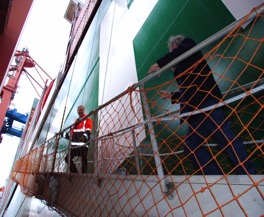During my recent business trip throughout Germany, the Hamburg Senate adopted a visionary “Digital City Strategy” to optimize value from the new era of massive digitalization. As  part of the initiative, a Digital City Control Center will be established in the Senate Chancellery to analyze data and improve citywide processes and projects with strategic partners.
part of the initiative, a Digital City Control Center will be established in the Senate Chancellery to analyze data and improve citywide processes and projects with strategic partners.
“If Hamburg wants to shape this policy, now is the time to act,” said Hamburg’s First Mayor Olaf Scholz. And at the World Economic Forum in Davos last week, German Chancellor Angela Merkel also asserted that “a digital offensive would create high-quality jobs and would help boost EU employment.”
Digitalization efforts are gaining momentum throughout Germany, fueled in part by the country’s Industry 4.0 initiative, and Hamburg in particular should be commended for its enterprising actions. Officials and industry leaders here recognize that a citywdide information infrastrcuture is essential to extracting full value from digitalization and the Internet of Everything — the connection of data with people, processes and things
At the bustling Port of Hamburg, Europe’s second largest and only growing port, CEO Jens Meier attributes recent record results and efficiency gains to technology. While here, Jens invited me aboard the, “CSCL Globe (China Shipping Container Line) ”, the world’s largest container ship. Longer than four soccer fields, the ship can transport 19,100 (TEU) containers. Hamburg was the mega ship’s first European port-of-call on its maiden voyage.
 IoEis playing a significant role in reducing operating costs, synchronizing the lifting and lowering of bridges with road and water traffic, improving collaboration among employees and citizens in adjacent Hamburg. Without these advances, the port would not have been able to accommodate and attract such a mammoth vessel or prepare for a doubling of container volume over the next several years, said Jens.
IoEis playing a significant role in reducing operating costs, synchronizing the lifting and lowering of bridges with road and water traffic, improving collaboration among employees and citizens in adjacent Hamburg. Without these advances, the port would not have been able to accommodate and attract such a mammoth vessel or prepare for a doubling of container volume over the next several years, said Jens.
The port and city of Hamburg are transforming into a powerful Seatropolis. The digital interconnectedness of port and city is a prime example of the “network multiplier effect”: The more inter-connections among nodes the greater the value of IoE. We’re proud at Cisco to be partnering with the Port of Hamburg, and we’re confident our advances will make a big splash when it showcases IoE projects as Hamburg hosts the World Ports Conference in June.
Back on land, I experienced the future of living at the IoE-enabled Apartimentum, a fully connected complex of ultra-smart apartments in the center of Hamburg pioneered by entrepreneur, Lars Hinrichs, who clearly values the benefits of smart technology.
When these “instant comfort” smart homes are available later this year, residents will live at the apex of the digital and physical worlds. With sensors embedded most everywhere and in most everything throughout the complex, combined with a robust network communicating with mobile devices, residents can use digital keys, regulate temperatures remotely, get alerts when milk is low in the refrigerator, set preferred shower programs, control LED lighting and much, much more.
Cisco provides the IP-enabled network infrastructure here, enabling lights, phone, music, lighting and more to run over Internet addresses, reducing energy and costs while enhancing speed, comfort and convenience.
IoE-related forums regularly now throughout Germany, such as the MLove Salon Smart City Summit I attended while in Hamburg. I also had the honor of addressing industry and government leaders at the Rotary Club of Hamburg’s annual New Year’s event. Here too leaders across industries recognize the unprecedented potential of the Internet of Everything in addresings our major social, economic and environmental challenges.
All in all, Hamburg and Germany appear to be superbly positioned to take advantage of the Internet of Everything’s digital revolution.
Notes:
Cisco’s consultants calculate that the Internet of Everything unleashes a $19 trillion opportunity in profitability and cost savings worldwide over the next decade. For Germany, we calculate that IoE can create $913.8 billion in value — $736 billion in the private sector and $177.8 billion in the public sector.
While in Munich, Frankfurt and Hamburg, industry executives from global brands and local government officials wanted to explore how to advance opportunities to digitalize their operations to enhance productivity, asset utilization, innovation, customer experiences and more.


Thank you for this wonderful Blog Post. We feel honored that Wim Elfrink and John Baekelmans have visited the Apartimentum and we are delighted to read about it on your blog.
Kind regards
Enri